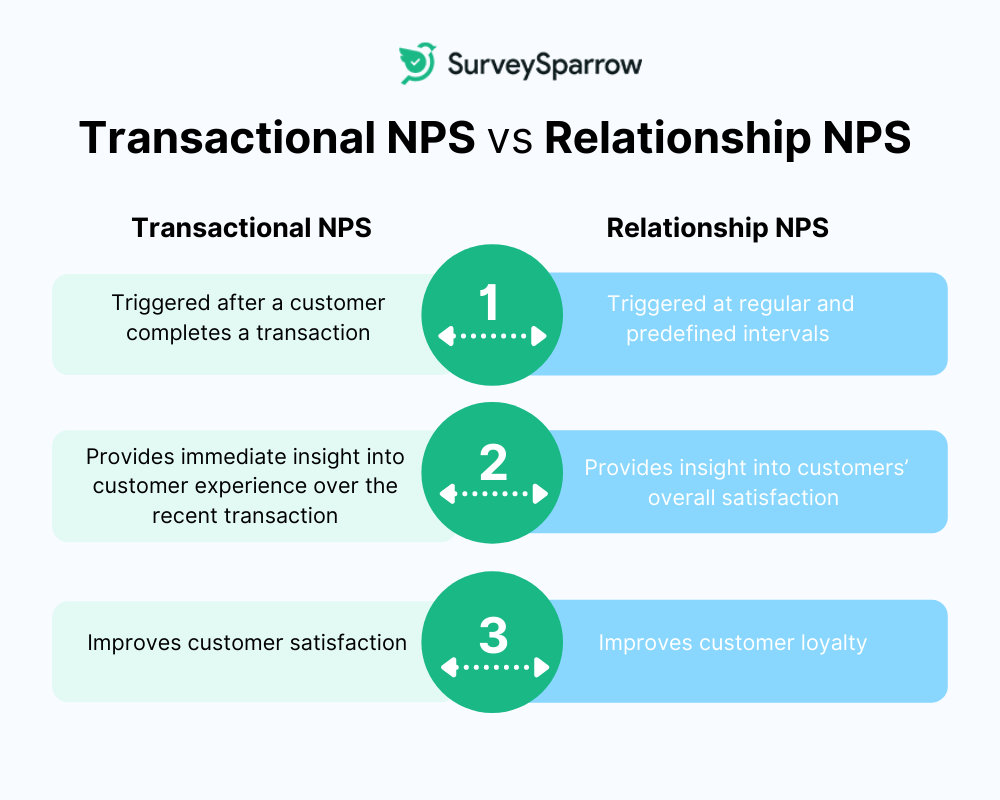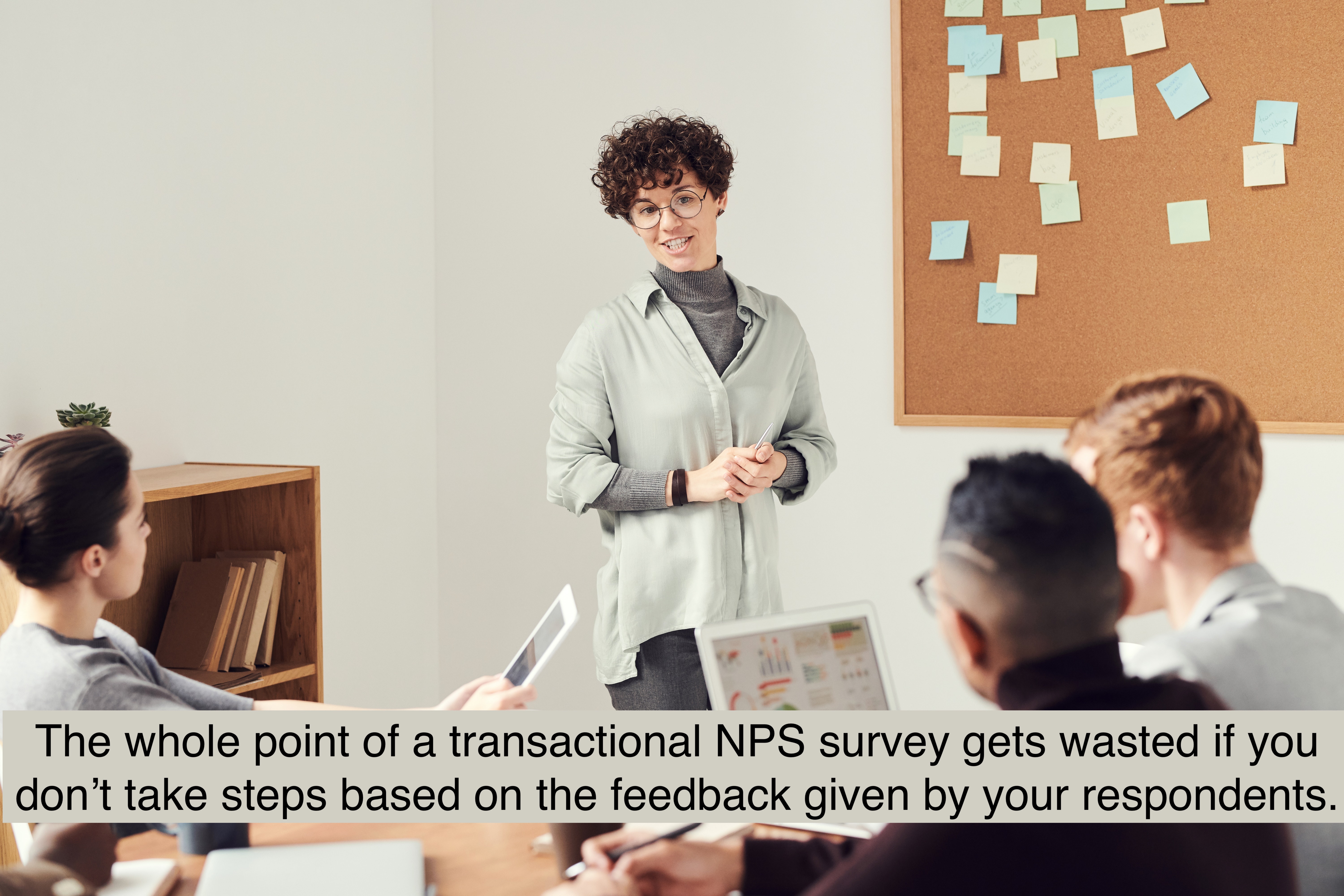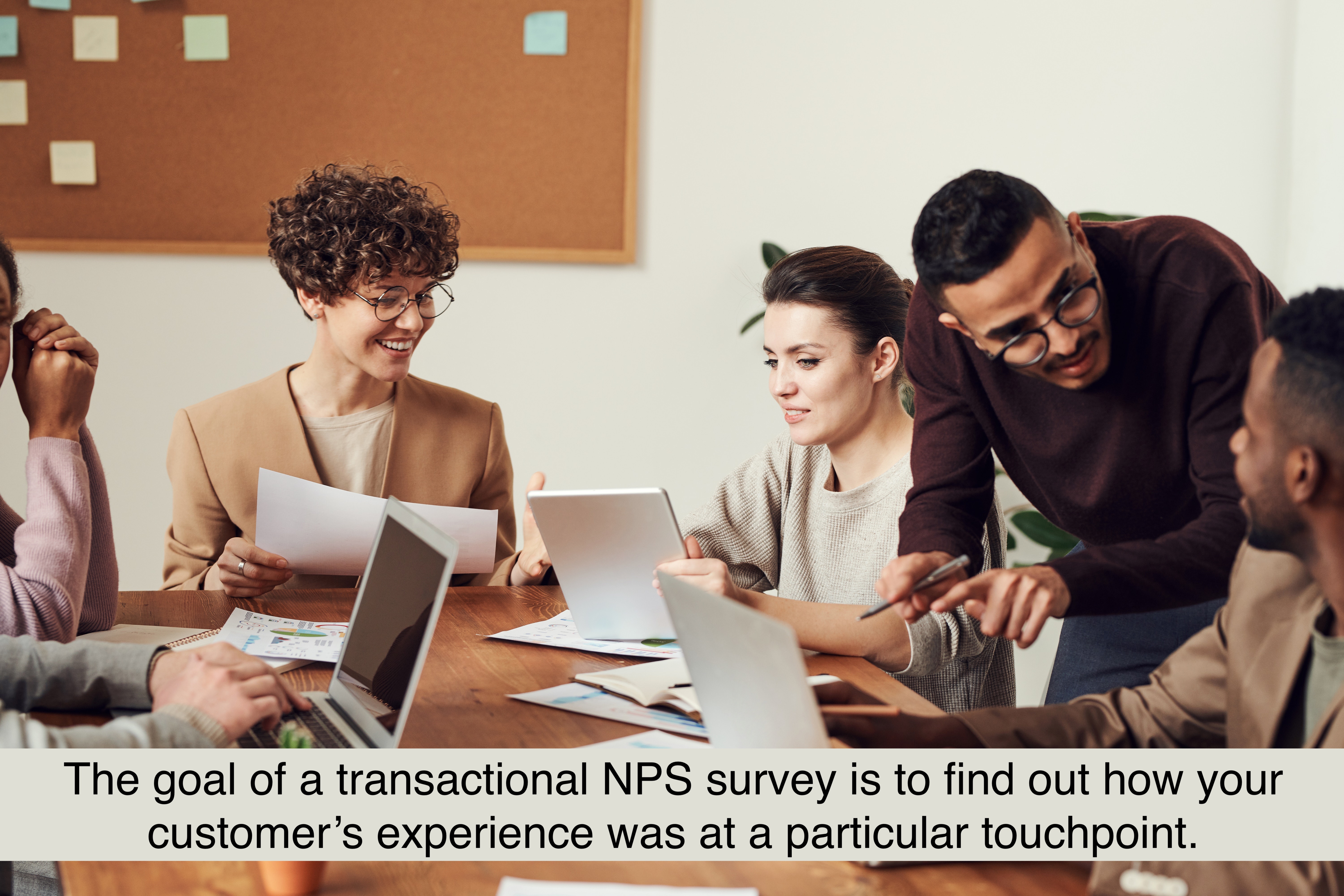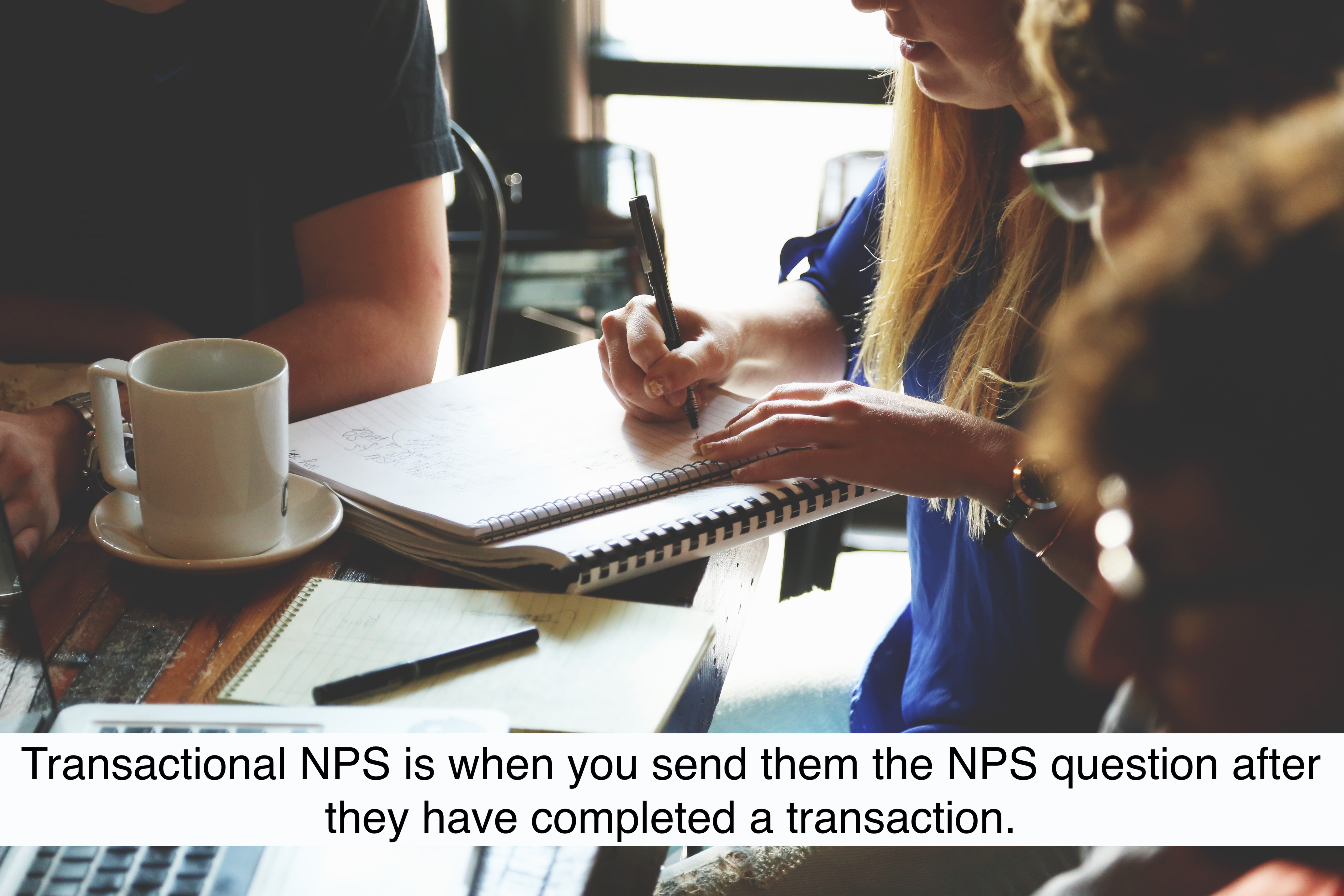NPS
Transactional NPS vs Relational NPS — Definition & Key Differences
Article written by Mathew Maniyamkott
Regular contributor to various magazines. Passionate about entrepreneurship, startups, marketing, and productivity.
12 min read
19 September 2025

Before we dive into Transactional NPS, What’s NPS at its core?
Well, NPS® is a simple and powerful metric that measures how customers perceive your brand. Often involving the question “How likely are you to recommend our product to your friends and family?”, the NPS scale ranges from 1 to 10.

So, the greater the scores of 9 and 10, the better your company’s NPS scores are. NPS® allows you to capture feedback at important intervals during the customer journey. There are two different types of NPS.
- Transactional NPS – when you send an NPS question after someone has completed a transaction.
- Relationship NPS (rnps) – surveys sent at regular intervals where there is no specific agenda.
Here’s what we’ll cover in this blog:
- Transactional NPS vs Relationship NPS
- How should a business use Transactional NPS?
- When to use transactional NPS?
- How to collect transactional NPS data
- How to have a successful transactional NPS survey process
What is Transactional NPS?
Transactional Net Promoter Score (tNPS) is a variant of the standard Net Promoter Score (NPS) that focuses on measuring customer loyalty and satisfaction based on specific transactions or interactions. Unlike traditional NPS, which is generally measured at regular intervals to understand overall customer loyalty, tNPS is collected immediately after a transaction or interaction. This method provides immediate feedback on the customer’s experience with a particular service, purchase, or interaction, making it more specific and actionable for understanding and improving the customer experience in real time.
So, what exactly does transactional NPS do?
It gives the business an opportunity to understand how they are performing at important customer touchpoints. Since the respondents of the survey aren’t anonymous, it gives you an opportunity to check back with them if they don’t seem happy based on their responses to the survey.
If a user responds by saying that they had a bad experience, then the onus is on the business to make amends either by calling to know more or solving the problem immediately with the information at hand.
What is Relational NPS (rnps)?
Relational Net Promoter Score (rNPS) is used to assess a customer’s overall loyalty and satisfaction with a brand or company over a longer period. Unlike Transactional NPS (tNPS), which focuses on specific interactions or transactions, rNPS measures the customer’s general sentiment towards the brand or organization as a whole.
This metric is typically gathered at regular intervals, such as quarterly or annually, to track changes in customer sentiment over time and to gauge long-term customer loyalty and satisfaction. It provides valuable insights into the overall health of the customer relationship beyond individual transactions or interactions.
Transactional NPS vs Relationship NPS: Which one should you use?
The most honest answer one will get is that there is no method that can be considered better than the other. They have their own advantages and disadvantages. Business Broadway says that relationship NPS helps you make strategic decisions, while transactional NPS helps you make tactical decisions.

Since transactional NPS is related to a specific product, service, event, or area, it can be easily acted upon. When you have a huge pool of data from transactional NPS surveys, it is possible for you to find faults, weaknesses, opportunities, threats, etc.
Sign Up for Free and Witness How Well SurveySparrow’s NPS Software Suits Your Needs.
14-day free trial • Cancel Anytime • No Credit Card Required • No Strings Attached
How should a business use transactional NPS?
- Transactional NPS surveys are conducted only when you have already sent a lot of relationship NPS surveys. It will help you find which are the touchpoints that affect the customer’s relationship with the company.
- The effectiveness of transactional NPS, whether it is for B2B or B2C. It is entirely dependent on how your employees ensure that the issues are resolved without a hiccup.
- Your NPS relationship survey should be based on the results of your transactional survey, where customers mention the touchpoints that have given the most headaches. Also, transactional NPS surveys should not be sent at every touchpoint but in stages so that the respondent doesn’t feel overwhelmed.
Send transactional NPS surveys as soon as the customer interacts at a touchpoint, but as we mentioned earlier, do not use it at every juncture.
When to use transactional NPS?
Transactional NPS can be used best in the following scenarios outlined below:
- When you would like to get the NPS score for each department
- When you are looking to identify the strengths and weaknesses at touchpoints,
- When you want actionable data on how to improve the touchpoints in the customer journey.
How to collect transactional NPS data:
1. New transaction
You can send transactional NPS surveys immediately after your customer places a new order or completes a business transaction. This is one of the must-send places because customers have issues at transaction points, and you want to make sure that the action that they tried to take has been completed without issues at any end.
Also, remember that transactional surveys are highly actionable, and if there is any issue that the customer mentions in the survey, you need to take immediate action to solve it. Even a quick call isn’t out of order. Once you come up with the solution, you need to figure out why the issue happened in the first place. Acts like this will help you create a much better product and streamline your services in a way that would have been unimaginable before NPS.
2. Ticket creation
Send a transactional NPS survey after a ticket has been created for a customer based on his/her complaint. This will help you understand how your customer service executive handled the customer’s issue. You can also know if a solution has already been proposed to the customer or how long it will take to get a resolution. Since there are a lot of complaints that the customer service team gets, you will be able to see how your team fares in that department.
The management can observe the tone and words used. If the customer has not been properly taken care of, they will reply to the same, saying that they have not been treated properly. When you engage with your clients in places like this, you will be able to understand the areas where there are problems.
3. Feature addition
Your NPS survey has a huge part when it comes to product updates or new features. Imagine having a huge error but not noticing it, and there is no easy way for your customer to let you know of it. But sending a transactional NPS survey as soon as they get a major product update puts you in good stead, where the customer can share their views with ease.
The transactional NPS survey results will also help you figure out which features are in demand, which ones can be taken off, and so on. It helps you understand the issues that a customer might be facing, something which you would have completely ignored.
How to have a successful transactional NPS survey process:
There are a lot of elements that go into making a successful transactional NPS survey. Below are some points that you can use to create a transactional NPS survey that works well.
Qualitative feedback:
The nature of the survey should be qualitative. The questions should be phrased in such a manner that it helps you make important changes to your business. The very core of your business might be challenged based on the comments from the survey; thankfully, that’s exactly what you need to know. It is difficult to function with a process that is flawed. The results from a transactional NPS survey take off that cover.
More the merrier:
Too many cooks don’t spoil the broth when it comes to getting feedback from customers using surveys. The more respondents you have for your survey, the higher the accuracy of the results as it reduces inconsistencies in the outcome. Getting feedback regularly from the same interaction points will help you make drastic changes based on the survey responses.
Let’s say you manage to get high ratings from the customer for a particular touchpoint; don’t hesitate to ask why they have given you a desirable rating. You might uncover answers that you rarely expected. Using that feedback, you can work on making it stronger.
Close the loop:
The whole point of a survey gets wasted if you don’t take steps based on the feedback given by your respondents. Closing the loop is all about asking follow-up questions to the respondents and seeing if they need further help. If not, you need to take action from your side. Once you have made the desired changes, ensure that you send your customers the message that their complaints have been worked upon and there will be no issues in the future.
Timely action:
When it comes to transactional NPS, if you don’t end up taking evasive action as soon as you get a response, then it is an exercise in futility. Also, the transactional NPS should be sent to the customer as soon as they make a transaction. Since the transaction is fresh in the minds of the respondent, their response is most accurate on how they feel about it.

How do you create a transactional NPS journey?
With transactional NPS, the business will get deep insights into each touchpoint. The insights from this exercise will help you make business decisions that will alter the prospects of your company. If you are not sure how to go ahead with transactional NPS for your business, here’s what you can do.
#1 List the touchpoints:
There might be several interaction touchpoints, or only a few, based on your product or service. If there is a lot, then determine the ones that are important enough to be included in the transactional NPS survey. Also, write down the names of the touchpoints which are the ones that give the most value to you as a business. For example, it could be the payment gateway page, Add to the Cart page, billing, ads, service, live chat, follow-ups, emails, etc.
#2 Choose the platform
The next step is to identify which is the most effective channel where you will pass the surveys. It could be over a telephone call, in-person interviews, email surveys, etc. The most effective method is to send transactional NPS surveys through emails using online survey tools like SurveySparrow. You can even use devices that you can take to the customer in person, and the responses are directly fed into a system.
#3 Survey design:
You can design transactional NPS surveys using online survey tools like SurveySparrow. We would advise you to keep it simple with respect to the NPS question. Use appropriate follow-up questions that you think might be relevant for the touchpoint. Go a step ahead and ask if the customer (read respondent) would like anyone from your team to contact them.
#4 Calculate your NPS
Find out your NPS score using its formula. Once you have the NPS score, compare it with your immediate competitors. Use the NPS score as a benchmark and compare it against your score when you take it. This will help you understand if you are making your customers happy or they are getting discontent with you. The objective should be to keep increasing the NPS score.

Conclusion
The goal of a transactional NPS survey is not to find out how satisfied your customers are with the company but to see their experience at a particular touchpoint. To put it as simply as possible, you need to find out which touchpoint your customers refer to when they give a score. This is why Relationship NPS precedes transactional NPS.
As we have mentioned in the article, transactional NPS helps you find out the kind of impact each touchpoint has on your customer. It allows you to find areas that need improvement so that you can create experiences for your customers that make them happy.
Using transactional NPS properly will put you in good stead with your customers, as you will easily solve their problems. You can use NPS as KPIs for your employees so that they take it seriously. Send out NPS surveys using SurveySparrow’s highly intuitive online survey tool. With SurveySparrow’s assistance, create a better business that your customers love.

Explore Deeper Customer Insights with SurveySparrow
A personalized walkthrough by our experts. No strings attached!

Get up to 40% more NPS responses and finally understand what drives loyalty.
Mathew Maniyamkott
Guest Blogger at SurveySparrow
Related Articles

NPS
The Ultimate Guide To Employee NPS (2024)
12 MINUTES
25 August 2019

NPS
How to Control and Reduce Churn using NPS?
13 MINUTES
6 May 2020

NPS
8 Simple Yet Powerful Ways to Use NPS to Increase Sales
17 MINUTES
20 April 2020

NPS
What Is Net Promoter Score Facts & 12 Factors That Will Blow Your Mind!
20 MINUTES
27 June 2021

